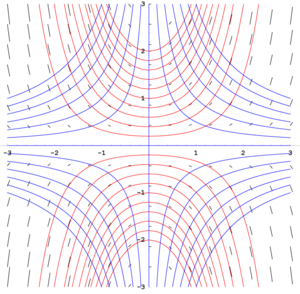
Isocline
Encyclopedia

Greek language
Greek is an independent branch of the Indo-European family of languages. Native to the southern Balkans, it has the longest documented history of any Indo-European language, spanning 34 centuries of written records. Its writing system has been the Greek alphabet for the majority of its history;...
words Isos (ισος) meaning "same" and Klisi (κλίση) meaning "slope".
It is often used as a graphical method of solving ordinary differential equations. In an equation of the form y' = f(x,y), the isoclines are lines in the (x, y) plane obtained by setting f(x,y) equal to a constant. This gives a series of lines (for different constants) along which the solution curves have the same gradient. By calculating this gradient for each isocline, the slope field
Slope field
In mathematics, a slope field is a graphical representation of the solutions of a first-order differential equation. It is achieved without solving the differential equation analytically, and thus it is useful...
can be visualised; making it relatively easy to sketch approximate solution curves; as in fig. 1.
In population dynamics
Population dynamics
Population dynamics is the branch of life sciences that studies short-term and long-term changes in the size and age composition of populations, and the biological and environmental processes influencing those changes...
refers to the set of population sizes at which the rate of change, or partial derivative, for one population in a pair of interacting populations is zero.

